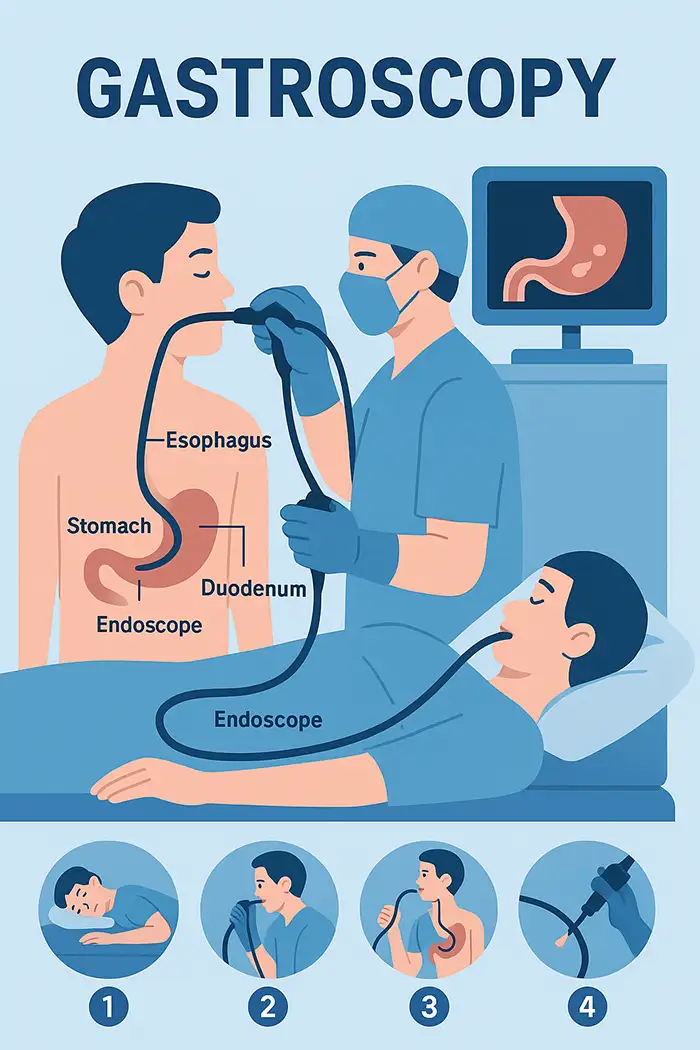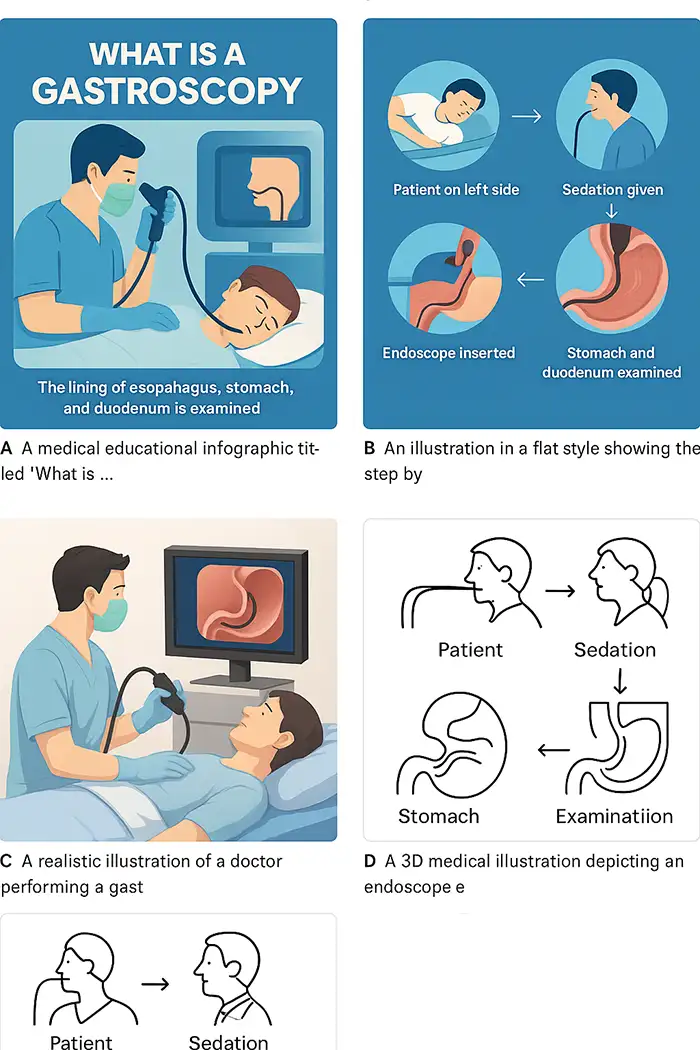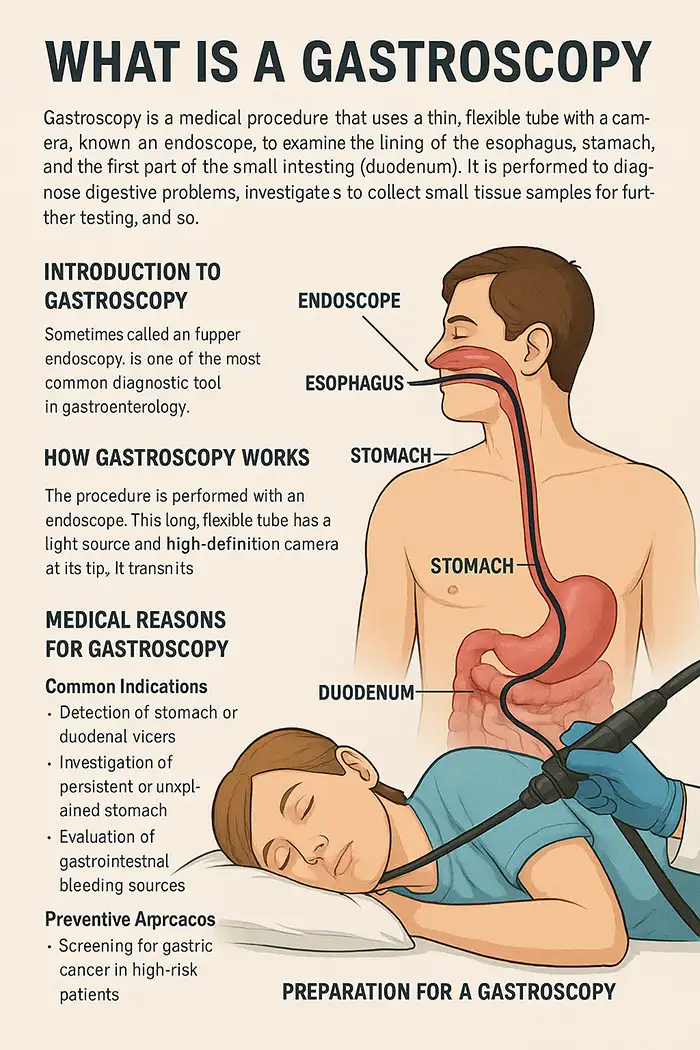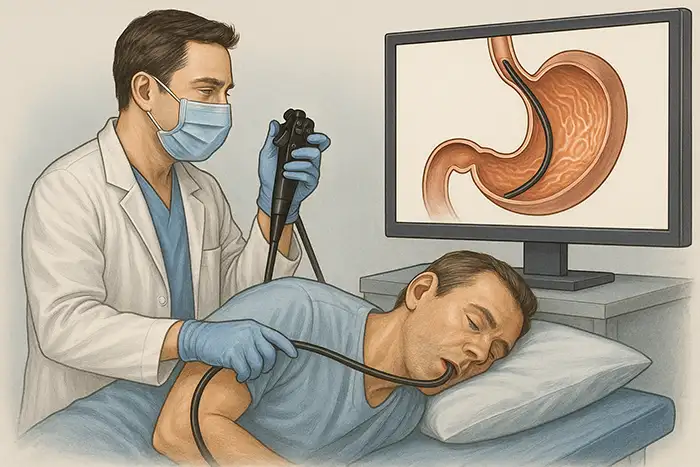Table of Contents
Gastroscopy, also known as upper gastrointestinal (GI) endoscopy, is a minimally invasive medical procedure that allows direct visualization of the upper digestive tract, including the esophagus, stomach, and the first portion of the small intestine (duodenum). The procedure is performed using a flexible tube called a gastroscope, which is equipped with a high-definition camera and a light source. The primary purpose of gastroscopy is to diagnose and sometimes treat gastrointestinal conditions, providing real-time images that are more precise than other imaging modalities like X-rays or CT scans.
Gastroscopy is widely used in hospitals, clinics, and specialized gastroenterology centers for both diagnostic and therapeutic purposes. Conditions such as gastritis, peptic ulcers, polyps, tumors, and early-stage cancers can be identified, and tissue biopsies can be collected for histological analysis. The procedure typically takes 15 to 30 minutes, depending on complexity, and is considered safe with a low risk of complications.
The evolution of gastroscopy over the past decades has been driven by advancements in technology, including high-definition imaging, narrow-band imaging, and integration with artificial intelligence (AI), which help physicians detect subtle mucosal changes and improve diagnostic accuracy.
Gastroscopy provides direct visualization of the esophagus, stomach, and duodenum.
It detects conditions not visible through standard imaging, such as gastritis, ulcers, Barrett’s esophagus, or early-stage gastric cancer.
Allows simultaneous diagnostic evaluation and therapeutic interventions.
Important for patients with persistent upper abdominal pain, unexplained gastrointestinal bleeding, or chronic reflux.
Enables tissue biopsies for histopathological assessment, crucial for diagnosing H. pylori infection, celiac disease, or early tumors.
Supports preventive medicine by identifying precancerous lesions early.
Reduces the need for multiple visits and allows immediate intervention.
Improves patient care, early detection, and treatment outcomes.
Flexible tube with high-definition camera and light source.
Working channels allow biopsy, polyp removal, hemostasis, or cytology.
Advanced features: narrow-band imaging, magnification, chromoendoscopy, digital enhancement.
Supports recording and storage of real-time video for documentation or telemedicine.
Patient lies on left side; local anesthesia or mild sedation applied.
Gastroscope inserted through mouth, navigating esophagus, stomach, and duodenum.
Mucosa examined for abnormalities; biopsies or therapeutic interventions performed if needed.
Images displayed on high-definition monitor for documentation.
Evaluates upper gastrointestinal bleeding and locates treatment sites.
High-risk patients screened for early precancerous changes.
Monitors chronic conditions like Barrett’s esophagus.
Combined with biopsy, blood tests, or H. pylori testing for comprehensive care.
Persistent upper abdominal pain or dyspepsia.
Detection of gastric or duodenal ulcers causing bleeding or obstruction.
Evaluation of gastrointestinal bleeding (hematemesis or melena).
Monitoring gastritis, esophagitis, or Barrett’s esophagus.
Diagnosis of H. pylori infection.
Screening for gastric and esophageal cancer in high-risk patients.
Early detection of dysplasia or adenomas.
Risk stratification for lifestyle-related factors (alcohol, smoking, diet).
Post-operative surveillance after gastric surgery or therapy.
Routine screening for patients over 50 or in high-prevalence regions.
Fasting 6–8 hours to ensure empty stomach.
Adjust blood-thinning medications if needed.
Provide complete medical history including allergies and prior anesthesia reactions.
Avoid smoking, alcohol, and certain medications before procedure.
Explain procedure, purpose, risks, and expected outcomes.
Address anxiety or claustrophobia.
Obtain informed consent for diagnostic and therapeutic purposes.
Arrange transportation post-procedure if sedation is used.
Continuous monitoring of vital signs.
Systematic examination to avoid missing subtle lesions.
Biopsies collected and therapeutic procedures performed if necessary.
Abnormal findings documented; images/video stored for records.
Mild pressure, bloating, or throat soreness is common but temporary.
Sedation or local anesthesia minimizes discomfort.
Procedures last 15–30 minutes; recovery in 1–2 hours.
Resume normal activities gradually; follow dietary and hydration advice.
Pain depends on sedation, gag reflex, procedure duration, and anatomy.
Patients under sedation usually feel minimal discomfort.
Topical anesthetic sprays or gels reduce gag reflex.
Mild IV sedation ensures relaxation.
Breathing and relaxation techniques help comfort.
Gentle technique by experienced endoscopist reduces stress.
Minor throat irritation or soreness.
Small risk of biopsy bleeding, usually resolves spontaneously.
Rare: perforation, infection, or sedation reaction.
Severe cardiopulmonary patients require extra monitoring.
Strict sterilization of endoscopes.
Monitored sedation by trained staff.
Emergency protocols ready for complications.
Regular staff training for safety and patient care.
Gastritis, esophagitis, mucosal inflammation, peptic ulcers.
Sources of gastrointestinal bleeding, polyps, tumors, H. pylori infection.
Precancerous lesions, Barrett’s esophagus, early gastric cancer.
Chronic conditions: recurrent gastritis, reflux, post-surgical changes.
Anatomical abnormalities: strictures, hiatal hernia.
X-rays: structural view, no biopsy.
CT scans: cross-sectional images, limited mucosal detail.
Capsule endoscopy: visualizes small intestine but no biopsy/intervention.
Direct visualization, biopsy capability, early lesion detection, therapeutic interventions.
Reduces need for multiple diagnostic visits.
Enables minimally invasive treatment.
Observation until sedation wears off (30–60 minutes).
Soft foods and hydration initially.
Mild bloating, gas, or throat discomfort usually resolves quickly.
Report severe abdominal pain, vomiting, or bleeding immediately.
Review biopsy results and follow-up management.
Periodic surveillance for chronic or post-therapeutic conditions.
High-definition imaging, narrow-band imaging, chromoendoscopy, 3D visualization for better lesion detection.
AI-assisted detection reduces human error and supports real-time diagnosis.
AI aids training by highlighting suspicious areas for new endoscopists.
Endoscopic mucosal resection for early tumor removal without surgery.
Hemostatic techniques control bleeding effectively.
Advanced devices enable minimally invasive interventions for polyps and strictures.
Evaluate diameter, flexibility, imaging resolution.
Consider supplier reputation, certifications, service quality.
Ensure compatibility with biopsy, suction, and therapeutic tools.
Balance cost and quality for maximum clinical value.
Consider warranty, maintenance, and training support.
Bulk vs. single-unit procurement based on clinical demand.
Gastroscopy is an indispensable tool in modern gastroenterology, combining diagnostic precision, preventive screening, and therapeutic capability. Its ability to visualize the upper GI tract directly, collect biopsies, and detect early lesions makes it invaluable in both routine care and high-risk patient monitoring. Technological advances such as high-definition imaging, narrow-band imaging, and AI-assisted detection have enhanced both diagnostic accuracy and patient comfort. Proper preparation, safety protocols, and post-procedure care further ensure optimal outcomes. Selecting high-quality equipment and reliable suppliers improves efficiency, safety, and patient care. Gastroscopy remains at the forefront of minimally invasive gastrointestinal diagnostics, playing a critical role in early intervention, preventive medicine, and improved patient quality of life.
Hospitals can select from standard diagnostic gastroscopes, therapeutic gastroscopes with larger working channels, and advanced models featuring high-definition imaging or narrow-band imaging.
All gastroscopy devices should comply with ISO and CE certifications, and suppliers should provide quality assurance reports, sterilization validation, and regulatory compliance documentation.
Yes, modern gastroscopes include working channels for biopsy forceps, polyp removal tools, and hemostatic devices, allowing both diagnostic and therapeutic procedures.
High-definition imaging, narrow-band imaging, and digital chromoendoscopy are recommended for detecting subtle mucosal changes and improving diagnostic precision.
Most suppliers provide 1–3 years warranty, preventive maintenance, on-site technical support, and spare parts availability to ensure long-term reliability.
Yes, many advanced gastroscopes support digital video recording, storage, and integration with PACS or telemedicine platforms for remote consultation.
Proper sterilization protocols, monitored sedation, and staff trained in emergency procedures are essential to ensure patient safety and compliance with hospital standards.
Suppliers often provide on-site training, user manuals, and digital tutorials, and may offer workshops for advanced techniques like AI-assisted endoscopy.
Common accessories include biopsy forceps, cytology brushes, injection needles, cleaning brushes, and disposable mouthguards for patient comfort and infection control.
Procurement teams should compare equipment specifications, after-sales support, warranty terms, and training services, choosing suppliers with proven clinical experience and certification compliance.
Copyright © 2025.Geekvalue All rights reserved.Technical Support:TiaoQingCMS